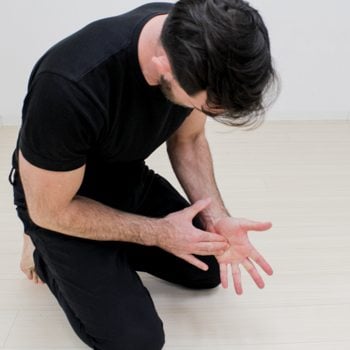Let’s be real here.
Unless you work in an industry that requires you to wash your hands often throughout the day, you probably don’t give much thought to skin dryness, cracking, or calluses.
 But training on the rings (and even on the parallettes) can force you to pause and consider your hand care regimen. These tools often cause discomfort on areas that aren’t used to this kind of stress or pressure, especially in the early stages of training.
But training on the rings (and even on the parallettes) can force you to pause and consider your hand care regimen. These tools often cause discomfort on areas that aren’t used to this kind of stress or pressure, especially in the early stages of training.
Over time, your skin will adapt and adjust to the pressures of the training tools.
In the meantime, it’s helpful to know what to expect and how to manage minor skin issues so that blisters and ripped skin don’t get in the way of your training progress.
Below, I’ll share a few hand care tips I’ve learned from my experiences in gymnastics and rock climbing.
Should I Use Gymnastic Grips or Gloves for Ring Training?
 First off, for the kind of training that we’re doing, I want to make it clear that there’s really no need to use gloves or gymnastic grips.
First off, for the kind of training that we’re doing, I want to make it clear that there’s really no need to use gloves or gymnastic grips.
Gymnastic grips are thick pieces of leather placed on the hand to help you hold on to the rings, and they can make a huge difference if you’re doing circles and big dynamic moves on the rings or parallel bars. While I used grips in my competitive gymnastic days, it’s just not necessary for the level of training you’re likely doing on the rings.
We also get asked about gloves, and I know a lot of people (including some friends of mine) do train with gloves. That’s fine, but for most of us, toughening the skin gradually is adequate.
There are probably some high-tech training gloves out there, but I’ve never used them or felt they were necessary.
Instead, I recommend building up good calluses for protection.
You’ll also develop a better sense of connection with the apparatus (rings, parallettes, or whatever) if you can actually feel it through your fingers.
Calluses Can Be Beneficial
How Calluses Develop
 A common issue we see with people just starting to train on the rings is that their hands are not prepared for the unique gripping on the rings.
A common issue we see with people just starting to train on the rings is that their hands are not prepared for the unique gripping on the rings.
Often, right at the start you may feel some discomfort on the skin of your palms, close to the fingers, as calluses form to allow your skin to adapt to the new pressure.
This is not a bad thing.
In fact, this eventually helps you attain a better grip on the rings. They may look funky, but calluses provide protection and a natural edge that actually aids your performance on the rings.
The problem is when they build up too thickly.
These thick layers of skin are not as pliable as the rest of your skin and though these thick layers are able to withstand friction and pressure by themselves, the softer layers underneath the callus cannot.
It’s the durability of the callus that’s the problem, since it can rip and take the softer layers of skin with it.
This not only creates a short term injury that can be a hassle to deal with at that moment, but it can also prevent you from training again until your hand heals back up.
Pumice Stones Aren’t Just For Ladies
 The callus on your hands is helpful, overall. However, too much of a good thing can still be bad and a thick callous should be addressed before it becomes a problem.
The callus on your hands is helpful, overall. However, too much of a good thing can still be bad and a thick callous should be addressed before it becomes a problem.
Time to break out the nail file or pumice stone and get to work!
If you are uncertain how much to file, work the callus down so that it is even with the rest of your hand. While the callus will still be harder than the rest of the skin on your palm, doing this will reduce the risk of the callus ripping.
This isn’t something that you’ll need to do daily. Just even out your skin every once in a while and you’ll save yourself some trouble.
Also, I’m sure that your significant other will also appreciate you taking the time to file those gnarly things down. GROSS.
How To Manage Rips
 Sometimes though, a rip can happen, especially after a period of intensive training. The friction generated from trying to hold on to the rings while spinning your body for multiple reps can be just too much for your skin.
Sometimes though, a rip can happen, especially after a period of intensive training. The friction generated from trying to hold on to the rings while spinning your body for multiple reps can be just too much for your skin.
There are different degrees of rips, but the major ones will require a specific treatment protocol.
Generally you’ll only get a major rip when your calluses are big and you’re cranking out dynamic moves that create a lot of friction. Major rips occur when the entire callus tears, along with several layers of skin below it. These rips generally tear at the bottom.
It IS possible to keep it from getting too bad, as long as you…
…Don’t Pick At It!
The first order of business is to not make it worse.
If you try and use your fingers to rip away the rest of the callus you will more than likely tear it upward toward your finger and take more skin with it. OUCH!
I assume you cringed as you read that!
For some reason we humans love picking at things, and it always amazes me when people pick at their callouses or scratches and make them worse.
DON’T be that person.
If you have a major rip, you’ve got a couple of options:
- Take a break from training
- Cover it up while you train
And of course, the third option is to see a doctor if things are really heinous.
Option #1 – Take Some Time Off
Don’t worsen things by continuing to practice the movement that caused the tear.
In most cases, pushing ahead will only make it worse. If your hand is bleeding, trying to tough it out and keep training doesn’t make you hardcore. Unless you are a competitive athlete, it just makes you a dumbass.
You’ll be fine if you take a couple of days off from training – no, you won’t lose your gains…
Option #2 – Cover it Up
Of course, back when I was a competitive gymnast, I didn’t have the luxury of taking time off. My team was relying on me, so I had to show up the next day and do at it again. So, what did I do?
Well, first I went and washed my hands with soap and water. If the rip was semi-bearable, I would tape it up and get back up there on the rings. Otherwise, I’d put lotion or Vasoline on the rip and then place my hand in a glove, sock, or plastic bag held with a loose rubber band, then keep it like that overnight.
Yeah, it wasn’t very comfortable to sleep like that. But this helped to keep the skin moist and protected while it healed.
So, “gloving it up” is one thing you can try when you get a major rip.
You may want to trim the remaining callused skin down before you do the glove method. Sometimes depending on the severity of the rip, you can leave it as is and it will fuse back together.
But this can take a long time.
Personally, I recommend cutting away the rip and the skin around it even if it is a minor rip. I would then put cream on it and cover it, since you want to get things healed as quickly as possible so you can get back to your workout.
Know When to Say When
 We really need to be realistic here.
We really need to be realistic here.
I’m not a gymnast anymore, and chances are, you’re not a professional gymnast either. So missing a day or two of ring training isn’t going to make or break your “score.”
Don’t pressure yourself into persevering through a major rip or tear on your hands just because you don’t want to lose your gains.
The best thing you can do is call it quits for a day and let your hand heal up before you get back to your workout. Take a break, let your hand heal, and then get back to it when you’ve given it enough time.
Otherwise, you may find yourself in a vicious cycle of continually re-injuring your hand without allowing your skin to adapt.
Thoughts on Moisturizers
I know some people that use creams on their hands after their workouts.
Personally, I don’t use creams or lotions since my skin doesn’t get very dry. A number of factors can affect your skin’s level of tolerance: genetics, diet, environment, climate, etc. The bottom line is that if dryness is an issue for you, be sure to work on healing your skin through dietary changes, or making use of appropriate lotions or creams.
Just be sure to apply any lotion or cream after your workout since they will cause your hands to slip when working out.
Cream, Sh-boogie Bop!
Want a recommendation? Here’s one: Burt’s Bees Hand Salve.
It’s made with natural ingredients, it’s very affordable, and a little goes a long way.
We also like that it doesn’t have a strong smell and absorbs into the skin fairly quick, so you don’t have to worry about getting grease all over everything after putting some on. You can buy this hand salve pretty much anywhere these days (even Wal-Mart) so head down to your local town center to check it out.
Don’t be fooled by any gimmicky fitness lotions or training creams. Although we haven’t looked, we’re sure there’s probably a high-priced training specific lotion out there, claiming to be the answer to all of your training woes. You don’t need that!
Giving Your Hands a Happy Ending
 When we first started GMB, we never imagined we’d one day write a blog post about moisturizers. But some of our favorite training tools put a lot of stress on the hands and skin, and clients have since asked us how to best care for their hands during the training process.
When we first started GMB, we never imagined we’d one day write a blog post about moisturizers. But some of our favorite training tools put a lot of stress on the hands and skin, and clients have since asked us how to best care for their hands during the training process.
But let’s be honest: It was pretty hard to write this post without making too many cracks about handjobs or various kinds of “cream.” But the fact is that your hands are important, and you need to take care of them.
Training while injured is generally not worth the risks. Toughen up your hands gradually and let them heal if they’re injured. Our wrist routine can also help!




